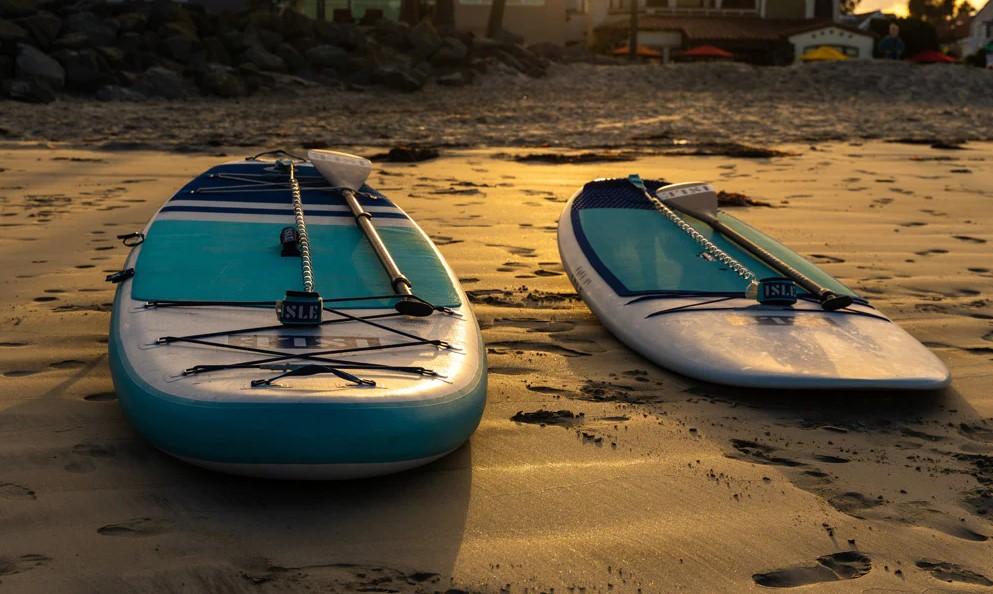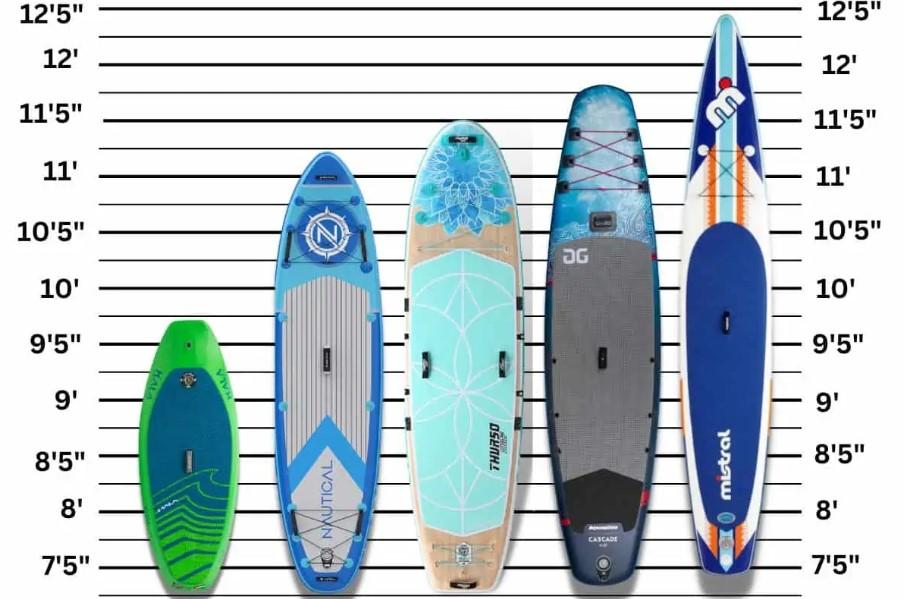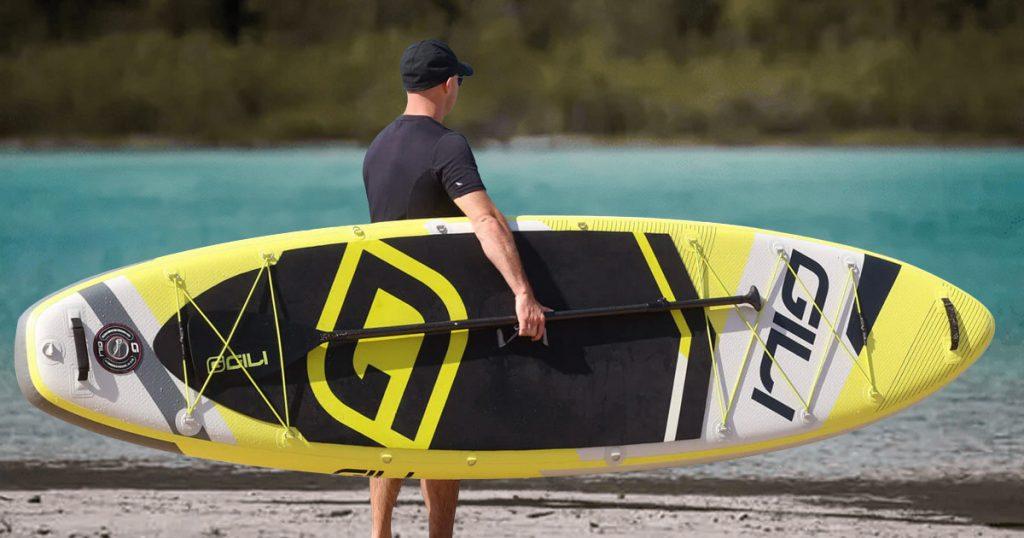Stand up paddleboarding, or SUP, has something for everyone. Whether you prefer a peaceful paddle on a lake, riding waves at the beach, doing SUP yoga, or getting a workout, the right board is essential for your fun. In this guide, we’ll cover the key factors to consider to help you choose a paddle board, such as what you need to look for and the different types of paddle boards available.
When choosing a stand-up paddleboard, think about how you’ll use it, how it fits your body, and its performance in water. Key factors include the board’s shape, volume, capacity, length, width, and thickness. Decide between solid or inflatable based on transportation and storage. Then, consider fins and extras that suit your needs.
Types of SUP Hulls
The hull, or body, of a paddle board affects how it performs in water, so it’s the first thing you need to look for in a paddle board. Most SUPs have a planing or displacement hull, with some combining both. Beginners can use either, but each is better suited for specific activities. Choose based on how you’ll use your board.
Planing Hull
A planing hull is flat and wide, like a surfboard. It rides on top of water and is great for leisure paddling, surfing, SUP yoga, and whitewater.
Displacement Hull
SUPs with displacement hulls have a pointed front, like a kayak. They slice through water smoothly, making paddling easier for longer distances and faster speeds. They track straight but are less maneuverable than planing hulls.
Solid vs. Inflatable
Planing and displacement hull SUPs come in two main styles: solid or inflatable.
Solid SUPs
Solid boards typically have an EPS foam core wrapped with fiberglass and epoxy, which is lightweight, durable, and affordable. Carbon fiber is lighter and stiffer, but pricier. Plastic SUPs are cheaper but heavier and less performant. Some use lightweight wood for a nice look. More of its benefits are:
- If performance matters most: Solid boards excel on the water, offering faster, smoother rides with less effort than inflatables. For speed and distance, go for a solid SUP.
- For the perfect fit: Solid SUPs come in a wider range of sizes and shapes than inflatables, increasing your chances of finding the ideal match.
- Prioritize stability: Solid boards are slightly sturdier than inflatables, offering a more stable feel, especially in waves. They also ride lower in the water, enhancing stability.
- Consider storage: Solid SUPs require ample space. If you have a garage and a suitable vehicle for transport, they’re a great choice.
Inflatable SUPs
Inflatable SUPs have PVC exteriors with drop-stitch construction, forming an air core. They include a pump for inflation and a storage bag. A good one should inflate to 12–15 PSI, feeling rigid when fully pumped. Some people choose this because:
- Limited storage space: If your home is small, inflatables are great since they deflate to fit in tight spots like closets or car trunks.
- Traveling: Inflatables are perfect for road trips or flights. Packed in their bag, they can be checked on planes or fit into any transport.
- Hiking to a lake: Inflatables are your go-to for alpine adventures. They’re heavy but manageable in their bag.
Whitewater paddling: Inflatables handle bumps better than solids, like rafts or inflatable kayaks. - SUP yoga: While not a must, inflatables are softer and more comfortable for yoga poses.

Volume and Weight Capacity
The size of your paddle board must also match your size. If it doesn’t displace enough water for your weight, you won’t feel supported and might find it unstable. Volume and weight capacity, influenced by the board’s length, width, and thickness, affect stability and water performance.
- Volume: A paddle board’s volume, measured in liters, shows how well it floats with weight. More volume means it can support more weight.
- Weight capacity: Every paddle board has a maximum rider weight it can handle. It’s crucial to match your weight with the board’s capacity. Overloading can make the board sit lower in the water and make it harder to paddle efficiently. Consider your body weight and any gear you’ll bring along.
- Volume and weight capacity for hull types: Planing-hull boards are forgiving, performing well as long as you’re below the weight limit. Displacement-hull SUPs are more sensitive. If you overload them, they’ll drag and feel slow. If you’re too light, they’ll feel heavy and hard to control.
SUP Length
Board length affects handling. Longer boards are faster, while shorter ones are more maneuverable. Consider your use when choosing length.
- Short boards (under 10′) are perfect for surfing or kids, usually with planing hulls for maneuverability.
- Medium boards (10′ to 12′) suit all-around use and SUP yoga. Most have planing hulls, but some are displacement-hull SUPs.
- Long boards (12’6″ and above) are for fast paddling and long-distance touring. They’re mostly displacement-hull SUPs, offering speed and straight tracking.

Image Source: What Size Paddle Board Should I Get: SUP Sizes Explained
SUP Width
Width influences handling. Wider boards are more stable but may be slower. If too wide, they can be hard to paddle. SUPs come in widths ranging from around 25 inches to 36 inches to suit different needs.
- For long tours or SUP yoga: choose a wider board for more storage and stability (31 inches or more). Narrower boards are faster and better for racing or surfing.
- Match the width to your body type: smaller people are better with narrower boards, while bigger people should opt for wider ones for balance.
- Consider your ability level: Experienced paddlers might prefer narrower, faster SUPs, while beginners might feel more secure on slightly wider boards.
SUP Thickness
Thickness matters on a stand-up paddle board because it influences volume and weight capacity. Thicker boards have more volume, meaning they can support more weight compared to thinner ones of the same length and width.
SUP Fins
Fins improve tracking and stability on a paddle board. Bigger fins with wider bases and longer front edges track straighter and offer more stability, while smaller fins are better for maneuverability. Most fins are removable for easy swapping and storage.
SUPs come in various fin configurations:
- Single fin: Offers good tracking and minimal drag, great for flatwater paddling.
- 3-fin setup (thruster): Promotes straight tracking on flatwater and provides good control in surf.
- 2+1 setup: Includes a larger center fin with smaller fins on each side, commonly found on surfing SUPs.
- Fins for inflatable SUPs: Can have any of the above configurations, with flexible rubber fins or detachable semi-rigid fins.

Choose the Right Paddle Board Based on Essential Factors Above
Ready to hit the water? Whether you’re cruising on calm lakes, catching waves at the beach, or doing SUP yoga, choose the right board for your adventure. Consider your size, paddling style, and where you’ll be using it. From solid to inflatable, there’s a perfect match for you. Dive in and start your paddle board journey today!
